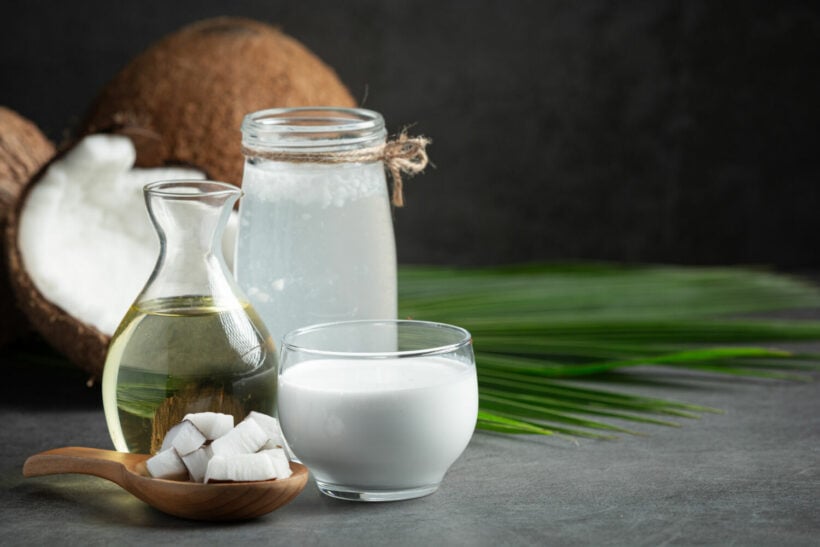Thai coconut milk desserts too delicious to miss

Coconut milk is one of the most popular ingredients Thais love to use in their dishes, including in their dessert. The rich, sweet, nutty, and salty flavours of coconut milk make Thai desserts too delicious to miss. So, if you love the creamy taste and aromatic flavour of coconut milk, then you might want to try the following desserts!
Sarim

Sarim is a colourful Thai dessert that consists of thin noodles (usually in the colour green and pink) made from mung bean flour, drenched in coconut milk and syrup, and served cold with crushed ice. Sometimes, shredded jackfruit and coconut flesh are added to the dessert to add more deliciousness. Yummy!
Sarim is said to be brought to Thailand from Java, Indonesia, during the King Boromakot era. It was allegedly modified from the “Lod Chong” or “Cendol” dessert, according to certain historians. One of King Rama II’s well-known poems is the earliest authentic description of Lod Chong’s appearance, describing both its look and flavour at the time. However, instead of ice, it was served with patchouli back then.
Bua Loy

There is no concrete evidence that bua loy came from Thailand. In fact, Malaysia and China each have desserts that resemble this delicious dessert. But regardless of its origin, this beautiful dessert is regarded as a Thai national dessert that has been around in the country for a long time.
Buay loy, which literally means “floating water lily”, consists of rice flour that is rolled into small balls and then cooked in coconut milk and sugar. The soupy dessert is made in various different flavours, such as pumpkin, sweet potato, and taro. One of the most popular ways to put bua loy is to put an egg into it, which is called Bua Loy Kai Wan.
Ko Nam Kathi

Ko nam kathi is a traditional Thai delicacy that tastes similar to bua loy. However, it has coconut fillings inside and is garnished with roasted white sesame seeds. It tastes salty and sweet, with a strong coconut aroma. These days, it’s incredibly difficult to find this dessert. Therefore, you’re in for a treat if you find one!
Kluay Buad Chee

This Thai dessert is actually pretty easy to make. Plus, the main ingredients are easy to find. These include bananas, sugar, and coconut milk. If you love bananas, this dessert is definitely a must-try since it has a beautifully balanced flavour of sweet and salty from the coconut milk and a bit sour from the bananas.
In the past, people in the northeastern part of Thailand would make a large pot of kluay buad chee for their family after a long hard day working on the farm. They would use the ingredients available in their own homes. That’s why the dessert uses common household ingredients. Additionally, they prepared this dessert when entertaining guests at their homes or making merit at the temple.
Pla Grim Kai Tao

The phrase “Pla Grim Kai Tao” was originally documented during King Rama IV. There used to be two sweets named “Pla Grim,” a long dough with a sauce made of palm sugar, and “Khai Tao,” a circular dough with coconut milk. According to history, Lady Plian Padsakorn blended the two desserts during the time of King Rama V. Thus, creating a sweet and salty deliciousness in one bowl. It was formerly known as “Chaeng Ma,” but today, everyone refers to it as “Pla Grim Kai Tao.” Like ko nam kathi, it’s also difficult to find pla grim kai tao. So if you happen to come across one, don’t miss out on it.
Tubtim Grob

Legend has it that Tubtim Grob was formerly a popular dessert among the local people. But one of King Rama V’s wives took this dish, made some adjustments, and served it as one of the king’s meals. He was so pleased with the flavour that he insisted it was made into a royal recipe, which led to the dish’s national fame and subsequent expansion to other regions. It’s essentially cubed water chestnuts wrapped in tapioca flour, eaten with sweetened coconut milk and shaved ice. The crunchiness of the water chestnut inside contrasts the jelly-like texture of the tapioca flour outside. This dish can be enhanced by adding shredded jackfruit and coconut flesh.
Sago Nam Kathi

Consist of mainly coconut milk and sago, Sago Nam Kathi is a Thai and Burmese dessert. Aside from the two main ingredients, the dessert also include coconut flesh, corn, longans, and taro in Thailand. Nowadays, the majority of “Sago Nam Kathi” products on the market are produced using tapioca pearls rather than actual sago pearls. This is due to the fact that sago palms require at least 8 to 10 years to attain the proper maturity and that harvesting and processing require a lot of labour.
Due to their increased cost and restricted availability, tapioca pearls have become more popular as a replacement. While tapioca pearls are white, true sago pearls are a dark brown colour. The tapioca pearls, however, are extremely tasty and nearly comparable to the real ones.
Krong Krang Nam Kathi

Krong Krang Nam Kathi has been a dessert since the Sukhothai era. It resembles a cockle form in several ways. It was formerly known as “Kanom Hoi Kraeng,” which is Thai for “cockle.” Later, it was renamed “Krong Krang Nam Kati,” and that is what we use today. While the flavour is comparable to bua loy, the dough’s consistency is different. Krong kram nam kathi is a lot more sticky than bua loy.
Although these desserts share the same main ingredient: coconut milk, most of them surprisingly have a distinct taste. They’re perfect for those hot afternoons when you need something refreshing to cool off!
Want to try more Thai desserts? Click HERE for more sweet deliciousness.
Latest Thailand News
Follow The Thaiger on Google News:


























